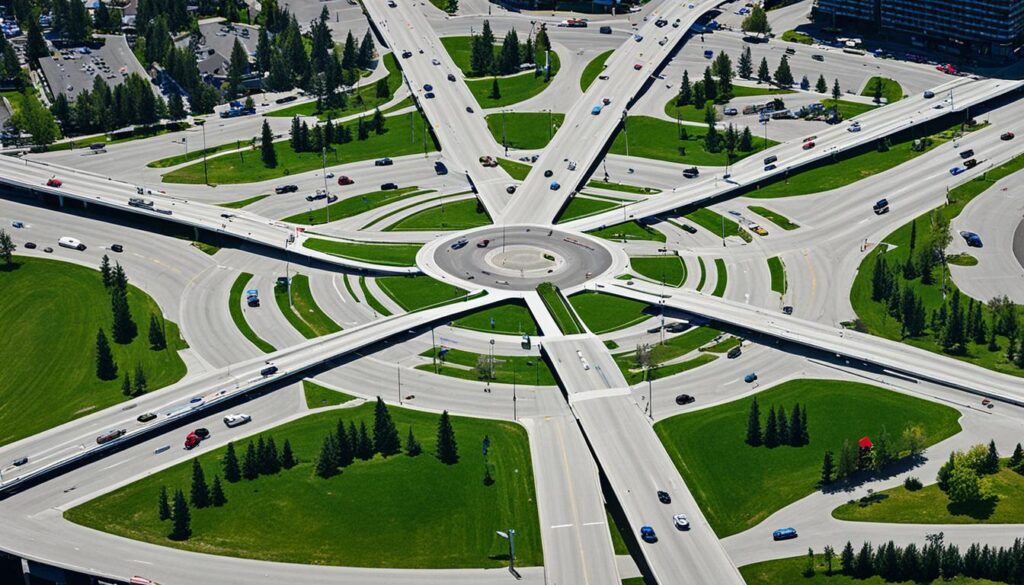Did you know that roundabouts have been shown to reduce collisions by up to 35% and injuries by 76% compared to traditional intersections? With the increasing use of roundabouts in Canada to improve road intersection safety and traffic flow, understanding how to navigate them safely is essential.
Roundabouts are designed to enhance intersection efficiency and promote safer travel for drivers, pedestrians, and cyclists. By following the roundabout design guidelines and knowing the rules, you can confidently maneuver through these circular intersections without any hassle.
Key Takeaways:
- Roundabouts in Canada have been proven to reduce collisions by up to 35% and injuries by 76% compared to traditional intersections.
- Navigating roundabouts safely requires understanding roundabout design guidelines and following the established rules.
- Roundabouts offer benefits such as improved traffic flow, reduced congestion, and a positive environmental impact.
- Drivers should yield to traffic already in the roundabout, choose the correct lane, and use signals appropriately when approaching and navigating roundabouts.
- With proper knowledge and adherence to roundabout rules, we can contribute to safer and more efficient roadways in Canada.
Benefits of Roundabouts over Traditional Intersections
Roundabouts offer several advantages over traditional intersections. They improve traffic flow by reducing congestion and delays. Studies have shown that roundabouts can reduce the number of collisions, injuries, and fatalities compared to traditional intersections. Roundabouts also have a positive impact on the environment by reducing vehicle emissions and fuel consumption.
Unlike traditional intersections where vehicles often come to a complete stop, roundabouts facilitate continuous traffic movement, minimizing traffic delays and keeping vehicles moving at a steady pace. This not only reduces congestion but also improves overall travel time for motorists.
The design of roundabouts promotes safer driving by providing a natural flow of traffic and decreasing the likelihood of high-speed, T-bone crashes. The circular layout reduces the number of conflict points, as vehicles move in a counterclockwise direction, eliminating the potential for head-on or right-angle collisions.
In fact, studies have shown that roundabouts can reduce fatal crashes by approximately 90% and injury crashes by 76%, making them a much safer alternative to traditional intersections.
Additionally, roundabouts have an environmental benefit. By keeping traffic moving steadily, vehicles spend less time idling, resulting in reduced vehicle emissions and improved air quality. Furthermore, the reduced number of stops and starts at roundabouts translates to lower fuel consumption, offering a more sustainable transportation solution.
Overall, the benefits of roundabouts over traditional intersections are clear. They improve traffic flow, enhance safety, and have a positive impact on the environment. Implementing roundabouts in various intersections around the country can lead to a more efficient and sustainable transportation system.
Roundabout Design Guidelines in Canada
When it comes to designing roundabouts in Canada, safety and efficiency are key considerations. The guidelines in place take into account various factors, including the volume of traffic, Canadian road infrastructure, and intersection design standards. By adhering to these guidelines, roundabouts are designed to accommodate different vehicle sizes and promote slower speeds for increased safety.
One important aspect of roundabout design is determining the appropriate size. This is influenced by the amount of traffic and the desired travel speed. Roundabouts should be sized in such a way that they can accommodate the expected volume of vehicles while ensuring a smooth flow of traffic.
In addition to size, roundabout design guidelines also address other important aspects such as lane widths, pedestrian and cyclist accommodations, and landscaping considerations. These guidelines ensure that roundabouts are not only safe but also visually appealing and integrated with the surrounding environment.
By following these roundabout design guidelines, Canadian road authorities aim to create intersections that are safer for all road users and contribute to the overall efficiency of the road network.
For a more detailed understanding of the roundabout design guidelines in Canada, refer to the table below:
| Guideline | Description |
|---|---|
| Traffic Volume | Consideration of existing and projected traffic volumes to determine the appropriate size of the roundabout. |
| Road Infrastructure | Integration with existing road infrastructure, including nearby intersections, highways, and access points. |
| Intersection Design Standards | Adherence to established intersection design standards to ensure consistency and safety. |
| Lane Widths | Provision of wide enough lanes to accommodate various types of vehicles, including large trucks and buses. |
| Pedestrian and Cyclist Facilities | Inclusion of safe and accessible crosswalks, sidewalks, and cycling paths to accommodate non-motorized users. |
| Landscaping | Consideration of landscaping elements to enhance the aesthetic appeal of roundabouts and create a pleasing environment. |
Note: The table above provides a summary of the roundabout design guidelines in Canada. For more detailed information and specific requirements, it is recommended to consult the relevant Canadian road authority guidelines or standards.
With these design guidelines in place, roundabouts in Canada can effectively serve their purpose of improving intersection safety and traffic flow.
Navigating Roundabouts – Approach and Yielding
When approaching a roundabout, it is crucial to follow the roundabouts rules and approach with caution. Reducing speed is the first step in ensuring a safe entry into the roundabout. Watch for road signs that provide information about upcoming roundabouts and lane allocations.
If you are approaching a multilane roundabout, it is important to choose the appropriate lane based on your intended exit. Take note of the road markings and signage that indicate which lane to use for specific exits.
Once you have chosen the correct lane, it is essential to yield to traffic already in the roundabout. The traffic in the roundabout has the right-of-way, and you must wait for a safe gap before entering. Make sure to look out for approaching vehicles and be prepared to yield if necessary.
Remember to prioritize the safety of pedestrians and cyclists when navigating roundabouts. They have the right-of-way at designated crosswalks, so be sure to yield to them before entering the roundabout.
In addition, it is essential to use your turn signals when approaching and navigating roundabouts. Indicate your intention to turn to inform other drivers of your planned exit. This helps improve communication and ensures smoother traffic flow within the roundabout.

Overall, following these roundabouts rules for approach and yielding will help ensure safe and efficient travel through roundabouts, promoting the well-being of all road users.
Navigating Roundabouts – Entering and Exiting
When approaching a roundabout, it’s crucial to understand the proper technique for entering and exiting. By following these guidelines, you can ensure a smooth and safe journey through the roundabout.
To enter a roundabout:
- Approach the roundabout at a moderate speed, obeying any reduced speed signs in place.
- Turn right to keep to the right of the island and follow the flow of traffic in a counter-clockwise direction.
- Continue around the roundabout, maintaining a steady speed and watching for pedestrians, cyclists, and other vehicles.
- Keep an eye out for signs indicating the lane, if applicable, for your desired exit.
- When reaching your intended exit, signal your intentions and carefully merge into the appropriate lane to exit the roundabout.
To exit a roundabout:
- Approach your desired exit with caution, watching for pedestrians and cyclists at the crosswalk.
- Before reaching the exit, activate and maintain your right turn signal to indicate your intention to exit.
- Check for any vehicles or pedestrians in your path and yield to them as necessary.
- Exit the roundabout smoothly, staying in your lane and continuing on your desired route.
It’s important to note that stopping or changing lanes inside a roundabout is strictly prohibited. This helps maintain a steady flow of traffic and prevents unnecessary conflicts.
Roundabout Rules in Ontario
In Ontario, roundabouts are becoming more common as a means to improve traffic flow and enhance intersection safety. As a driver, it is important to follow the roundabout rules and guidelines to ensure a smooth and safe journey.
Slowing Down and Yielding
When approaching a roundabout, it is crucial to reduce your speed and be prepared to yield to other road users. This includes pedestrians, cyclists, and other cars already in the roundabout. Yielding allows for a seamless flow of traffic and prevents potential accidents.
Choosing the Correct Lane
To navigate the roundabout effectively, choose the appropriate lane based on your intended exit. Pay attention to the road markings and signs that indicate which lane leads to your desired destination. By positioning yourself correctly, you can minimize confusion and safely navigate the roundabout.
Using Signals Appropriately
Signaling your intentions is an essential part of roundabout etiquette. Indicate your intention to enter or exit the roundabout by using your vehicle’s turn signals. This helps other drivers anticipate your movements and promotes smoother traffic flow within the intersection.
Remember, roundabouts are designed to enhance intersection efficiency and safety for all road users. By adhering to the rules and guidelines, you contribute to a safer driving environment.
Roundabout vs Traffic Circle
While roundabouts and traffic circles are both circular intersections, there are differences between the two. Traffic circles are larger and may require full stops at traffic lights. Roundabouts, on the other hand, have merge lanes and require drivers to yield to traffic already in the roundabout. Roundabouts are generally smaller and designed to improve traffic flow without the need for traffic lights.
Let’s take a closer look at the distinctions between roundabouts and traffic circles:
| Roundabouts | Traffic Circles |
|---|---|
| Smaller in size | Larger in size |
| No traffic lights | Possibly requires full stops at traffic lights |
| Merge lanes for entering and exiting | May have straight lanes for entering and exiting |
| Drivers yield to traffic already in the roundabout | Drivers may need to yield but can proceed without yielding |
Roundabouts are designed to improve traffic flow and safety by requiring drivers to yield to other vehicles in the roundabout. This allows for a continuous flow of traffic, reducing the need for full stops and decreasing congestion. Traffic circles, on the other hand, may require full stops at traffic lights, potentially leading to longer waiting times and increased delays.
Benefits of Roundabouts over Traffic Circles
Roundabouts offer several advantages over traffic circles:
- Improved traffic flow: Roundabouts promote a continuous flow of traffic, reducing congestion and delays.
- Increased safety: By requiring drivers to yield, roundabouts reduce the likelihood of high-speed collisions.
- Greater efficiency: Roundabouts are designed to optimize traffic flow without the need for traffic lights, improving intersection efficiency.
- Lower environmental impact: Roundabouts result in reduced idling and smoother traffic flow, leading to decreased vehicle emissions and fuel consumption.
Overall, roundabouts are a more modern and efficient approach to managing intersections, offering improved traffic flow, safety, and environmental benefits compared to traditional traffic circles.

Safety Benefits of Roundabouts
Roundabouts have proven to be much safer than traditional stoplight intersections. Numerous studies have consistently shown the significant safety advantages of roundabouts, making them an effective solution for collision reduction, injury reduction, and fatality reduction on our roads.
“Roundabouts can reduce the number of collisions by 35%, lower the number of injuries by 76%, and decrease fatalities by an impressive 90%.”
One of the key factors contributing to the enhanced safety of roundabouts is the slower speeds at which vehicles travel. The lower speed limits within roundabouts allow for better reaction time and reduce the severity of accidents. Additionally, the design of roundabouts reduces conflict points, minimizing the potential for collisions.
Compared to traditional intersections controlled by traffic lights, roundabouts offer improved safety for all road users, including motorists, pedestrians, and cyclists. Roundabouts provide a more predictable and efficient traffic flow, reducing the likelihood of sudden stops or unexpected movements that can lead to accidents.
Statistics Speak for Themselves
The statistics gathered from various studies provide substantial evidence for the safety benefits of roundabouts:
- Collisions reduced by 35%
- Injuries reduced by 76%
- Fatalities reduced by 90%
These figures demonstrate the significant impact that roundabouts can have in creating safer roadways and protecting lives.
The above image highlights the importance of roundabout safety, showcasing the efficient traffic flow and reduced conflict points that contribute to a safer driving environment.
By implementing roundabouts as a key part of our road infrastructure, we can continue to make substantial progress in reducing collisions, injuries, and fatalities on Canadian roads.
Roundabouts and the Environment
Roundabouts have a positive impact on the environment by reducing vehicle emissions and fuel consumption. This is achieved through several key factors:
- Reduced Idling: Unlike traditional intersections where vehicles often come to a complete stop, roundabouts promote a continuous flow of traffic. This minimizes idling time, which in turn reduces vehicle emissions.
- Lower Fuel Consumption: The smoother traffic flow in roundabouts eliminates the need for aggressive acceleration and frequent stops, resulting in decreased fuel consumption.
In addition to the direct effects on vehicle emissions and fuel consumption, roundabouts also contribute to a more sustainable and pleasant environment:
- Slower Speeds: Roundabouts typically feature lower speed limits compared to traditional intersections. This not only enhances safety but also reduces noise pollution and creates a calmer environment in suburban and urban areas.
- Landscaping Opportunities: Municipalities often take advantage of the central island in roundabouts to incorporate green space and landscaping. These additions further enhance the aesthetic appeal of the area and provide additional environmental benefits, such as improved air quality.
By implementing roundabouts in Canadian road infrastructure, we can contribute to a greener and more sustainable future while improving traffic flow and safety.
Roundabout Signage and Lane Guidance
When navigating roundabouts, specific signage and pavement markings are in place to assist drivers in making safe and informed decisions. These signs and markings serve as essential visual cues, providing important information about lane choices, traffic flow direction, and upcoming exits. Understanding and obeying these roundabout signs is crucial for a smooth and efficient driving experience.
The roundabout signs are strategically placed to guide drivers from a distance. They indicate the distance to the roundabout, allowing drivers to anticipate upcoming decisions and lane changes. Yield signs also serve as a reminder for drivers to yield to traffic already inside the roundabout, ensuring a safe and orderly flow of vehicles.
Once at the roundabout, drivers can find further guidance through the use of arrows on signs and road markings. These arrows indicate the direction of traffic flow within the roundabout, making it easier for drivers to navigate and choose the appropriate lane based on their intended exit. Following these arrows helps maintain the smooth flow of traffic and minimizes the potential for confusion or congestion.
| Sign | Meaning |
|---|---|
| Yield sign | Indicates that drivers must yield to traffic already in the roundabout |
| Directional arrows | Guide drivers in choosing the correct lane and direction of traffic flow within the roundabout |
| Distance signs | Indicate the distance to the roundabout, providing advanced notice for upcoming decisions and lane changes |
Remember, it’s crucial to pay close attention to these roundabout signs and markings, as they play a vital role in ensuring the safe and efficient movement of vehicles through the intersection. Adhering to these visual cues helps maintain the overall flow of traffic, reduces the risk of accidents, and leads to a more enjoyable driving experience for all road users.
Roundabout Etiquette and Tips
To navigate roundabouts safely, it is crucial for drivers to be confident and knowledgeable about the established rules. By following these guidelines, drivers can ensure a smooth and safe experience when navigating roundabouts.
- 1. Check for Reduced Speed Signs: As you approach a roundabout, be sure to keep an eye out for any reduced speed signs. These signs are in place to remind drivers to slow down and adjust their speed accordingly.
- 2. Yield to Traffic Already in the Roundabout: Before entering the roundabout, always yield to any traffic that is already in the roundabout. This ensures a smooth flow of traffic and avoids any potential collisions.
- 3. Use Signals Appropriately: Signal your intentions when entering, exiting, and changing lanes within the roundabout. This allows other drivers to anticipate your actions and adjust their driving accordingly.
- 4. Exit in the Correct Lane: It is important to exit the roundabout using the appropriate lane. Plan your route in advance and be sure to choose the correct lane as you approach the roundabout. This helps to minimize lane changes and potential conflicts with other drivers.
- 5. Drive Defensively: Always stay alert and be aware of other road users, including pedestrians and cyclists, when navigating roundabouts. Keep a safe distance from other vehicles and be prepared to react to any unexpected situations.
By following these roundabout etiquette and tips, drivers can ensure their safety and the safety of others on the road. Navigating roundabouts can be straightforward and efficient when drivers are confident and knowledgeable about the rules and guidelines.
Conclusion
In summary, navigating roundabouts and intersections in Canada requires a thorough understanding of the established rules and guidelines. Roundabouts provide numerous benefits, including improved traffic flow, reduced collisions, and a positive impact on the environment. By following the signage, yielding to other road users, and using signals appropriately, we can contribute to safer and more efficient roadways.
The importance of roundabout safety cannot be underestimated. Studies have shown that roundabouts significantly reduce the number and severity of collisions compared to traditional intersections. By promoting slower speeds and minimizing conflict points, roundabouts offer better reaction time and decrease the overall severity of accidents. This makes our roads safer for all road users, including pedestrians and cyclists.
Additionally, roundabouts have a positive environmental impact. By reducing congestion, idling time, and the need for traffic lights, they help lower vehicle emissions and fuel consumption. Roundabouts also create a more pleasant urban and suburban environment, with the opportunity for landscaping the central island.
